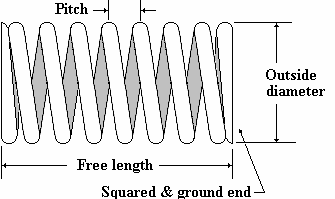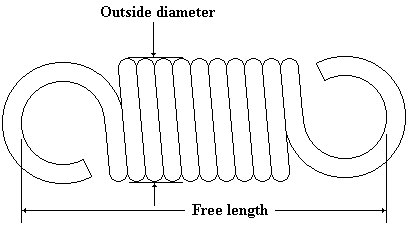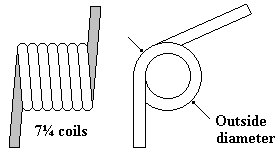GLOSSARY
These are many of the common words that have definitions in the springmaking field. The definitions are my own (caveat) and are admittedly not complete. This is not a dictionary - it's just another tool you can use to do a better job.
 |
|
- Active coil
- A coil of wire which contributes to the motive force of a spring. In extension and torsion springs, all the coils are active coils. In compression springs, only the coils which show daylight between them are active coils.
- Arbor
- A bar or pipe around which wire is wound to form a spring.
- Back gear
- A mechanism in a lathe that allows the chuck to turn very slowly.
- Beryllium copper (wire)
- An exotic material that can be made into springs.
- Bundle
- A roll or coil of wire as it is shipped from the manufacturer.
- Cast
- The curvature in wire that results from its being bundled into coils at the factory.
- Chrome Silicon (wire)
- An alloy of steel, stronger than Oil Tempered wire.
- Chrome Vanadium (wire)
- An alloy of steel, stronger than Oil Tempered wire.
- Closed and ground end
- Referring to the end of a compression spring where the wire forms one dead coil and is ground square.
- Closed end
- Referring to the end of a compression spring where the wire forms one dead coil and is not ground square.
- Coil
- 1) (noun) The wire of a spring going completely around once (see active coil, dead coil).
- 2) (noun) A bundle of wire as it is shipped from the factory.
- 3) (verb) To form (wire) into a spring.
- Compression
- Making smaller.
- Compression spring
- A spring which derives its usefulness because it pushes against a load which makes it smaller.
- Dead coil
- A coil of wire which does not contribute to the motive force of a spring. In extension and torsion springs, there are no dead coils. In compression springs, the coils at each end that lay against each other are dead coils: all the rest are active coils.
- Double torsion
- A form of torsion spring that has two coils; one left-handed and one right-handed, connected by a central tongue.
- Extension
- Making longer.
- Extension spring
- A spring which derives its usefulness because it pulls against a load which makes it longer.
- Free length
- The length of a spring with no load applied.
- Grinding stage
- A flat (usually) steel platform used to ensure that the ends of compression springs orient
correctly to a grinding wheel.
- Heat treat(ing)
- 1) The process of tempering metal.
- 2) (colloquially) The process of stress relief.
- Lathe
- A machine which derives its usefulness by rotating stock against which tooling may be brought to bear. Springs are often wound on a lathe.
- Lead screw
- A mechanism in a lathe that allows the tool post to move from side to side at a precise rate.
- Mandrel
- An arbor.
- Music wire
- A high-carbon steel alloy used in making springs.
- Open end
- Referring to the end of a compression spring where the pitch of the spring extends all the way to the end of the wire, and does not form any dead coils.
- OT (Oil Tempered wire)
- A lower-carbon steel alloy used in making springs.
- Passivate (-ation)
- The process of removing chemical coatings from stainless steel by immersion in an acid bath.
- Phosphor bronze (wire)
- An exotic alloy sometimes used in making springs.
- Pigtail
- A form taken by tie wire when used to secure a bundle of heavy spring wire.
- Pitch
- The distance, center to center, between two active coils of a compression spring.
- Spring [dia]
- A helically formed piece of (usually) wire which derives its usefulness because it tries to regain its original shape when subjected to a load. See Compression Spring, Extension Spring, Torsion Spring.
- Stainless Steel (wire)
- An alloy used in making springs that will not rust. The most common stainless steels are alled 302 and 17-7.
- Stress
- Misalignment of the molecules in wire due to bending.
- Titanium
- A strong, lightweight metal sometimes used in making springs.
- Tool post
- The part of a lathe that allows tooling to be mounted and used on stock.
- Torsion
- Twisting.
- Torsion spring
- A spring which derives its usefulness by trying to return to its original shape when subjected to a load traveling around its axis.
- Variable pitch
- A form of compression spring that has more than one pitch.
- Wind
- To coil (a spring).
- Wire
- Metal, usually round and solid in section, used in making springs.
Compression Spring:

Extension Spring

Torsion Spring

Forward to Site Map.
Terms of Use
|



